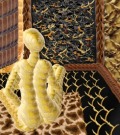|
Dragon
 |
Login, I believe most major newspapers have their printing presses in the same building as the newsroom. My understanding is that the news is written and edited upstairs and printed downstairs or at an adjacent building. I'm sure there are many journalists who send in their work by e-mail but there should be a central location for the editors. I would guess that the smaller publications that are filled with fluff pieces and small minded opinion pieces (at least in Red Deer, Alberta) probably rent time on the presses from the bigger newspapers. I could be totally wrong about that, I'm just guessing.
BTW, love that you recorded newspapers for the blind. I'd never thought of that but it really makes sense, I'm sure there aren't a lot of braille newspapers out there! What a great way to contribute to the community.
|
|
solosater
 |
I got to thinking about this, the major newspapers have to be in some way automated and computerized as they are released in markets around the globe and must be up to date or are worthless. You can get USA Today, The Washington Post, The New York Times, and I’m sure, many other newspapers in every major city in the world. They have to be printed locally or at the very least regionally.
So I went on the hunt. The info I found was not specific to any newspapers but I think the major global, regional and local city papers must all be printed using similar presses.
This is what I found on Encarta. It’s a little lengthy but I think we can all agree that the “typesetting†we’ve seen in historical movies and documentaries and human error in that department is not a viable excuse for the poor spelling we see.
There are links at the end to the full artical and to a seperate one on typesetting equipment.
By far the most important and versatile printing process today is offset lithography. The underlying principles were established at the end of the 18th century by a German map inspector, Aloys Senefelder, who was experimenting with methods of producing limestone relief printing surfaces using an acid etching process. Senefelder found that a wet limestone surface would repel an oil-based printing ink, and that an image drawn on the surface with a grease pencil would repel water and attract ink. Any drawing on the stone surface could be reproduced by bringing a damp sheet of paper into contact with the freshly inked image. This cycle could be repeated several hundred times before the drawing could no longer be faithfully reproduced.
The process, called chemical printing by Senefelder, quickly became a popular art medium because it enabled artists to produce multiple copies of freehand drawings. By the late 19th century, multiple stones were being used to transfer as many as 30 separate colors to a single sheet of paper to produce exquisite color lithographs that resembled fine watercolor paintings. Modern color lithography uses only four inks for a wide range of natural colors.
In the early part of the 20th century, it was discovered that ink could be transferred from the lithographic surface to an intermediate rubber surface and then to paper. The rubber intermediate, called a blanket, can transfer ink to paper and to a wide variety of materials that cannot be printed directly, including plastics and metals. Because the soft blanket conforms to the texture of the surface to be printed, lithographic image quality is unrivaled.
The function of the original stone printing surface is now served by thin aluminum plates, although other materials, such as stainless steel and plastic, can also be used. The plates are wrapped around the circumference of the printing cylinder and make direct contact with the rubber blanket cylinder. Rubber rollers carry ink and water to the plate surface. The ink is transferred first to the blanket cylinder and then to the paper.
Lithographic plates are the least expensive printing surfaces available today, and this fact has contributed greatly to the success of the process. Aluminum plate materials have a thin surface coating of light-sensitive material, such as a photopolymer, that undergoes a solubility change when exposed to an intense source of blue and ultraviolet light. Images are transferred to the surface by exposing the plate through a film positive or negative. Some materials can be exposed directly, as in a graphic-arts camera or by a computer-controlled laser beam, thereby eliminating the expense of film and speeding up the platemaking process.
Modern offset lithographic presses range in size from small sheet-fed duplicators—used for small, single-color jobs such as brochures and newsletters—to massive web presses capable of printing millions of copies of magazines, catalogs, mailing pieces, and packaging materials in full color. No other process has such a broad range of applications.
Relief printing processes work on the same principle as a rubber stamp. Ink is applied to the raised portions of the printing surface, and is then transferred by pressure to paper or some other substrate. Two forms of relief printing—letterpress and flexography—are currently in use, distinguished by the physical characteristics of their printing surfaces and inks. Letterpress printing is accomplished using a hard metal or plastic printing surface and a highly viscous ink. Flexography employs a soft rubber or plastic printing surface and a fluid ink.
In the late 1950s a radical new way of making relief printing surfaces was introduced; it employed a soluble plastic that hardened upon exposure to ultraviolet radiation. Since then a large number of photopolymer plate materials have been created. A thick coating of photopolymer on a metal or plastic support can be exposed to ultraviolet light through a piece of film that allows the light to pass through only those areas that will transfer ink. The photopolymer hardens, or polymerizes, in these areas, and the remaining unexposed coating is washed away with water or some other solvent. The result is a relief printing surface than can be mounted directly on a printing press.
In a variation of this process, a liquid photopolymer that solidifies when exposed to ultraviolet radiation is spread on a paper or plastic support. After exposure the unexposed liquid is blown away with air. These plates can be made rapidly and are therefore most suitable for newspaper printing, where deadlines are critical.
High-speed rotary web presses and photopolymer plates have allowed letterpress to remain competitive in some areas, such as in newspaper printing, despite the fact that lithography is now the uncontested leader among printing processes.
This is parts of an article on Printing Techniques from Encarta. The whole article is at:
http://encarta.msn.com/encyclopedia_761569714/Printing_Techniques.html#s2
This is a second article on Typesetting Equipment; I thought it was interesting.
http://encarta.msn.com/encyclopedia_761558642/Typesetting_Equipment.html
|
